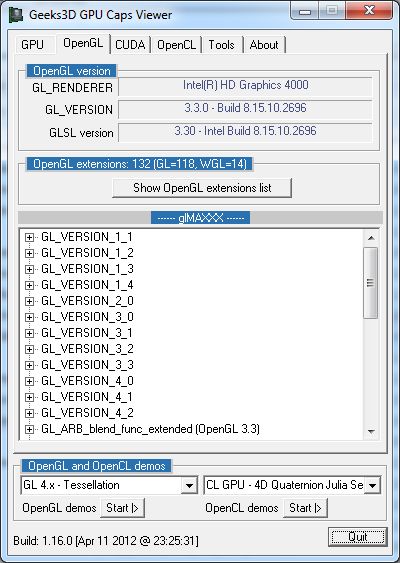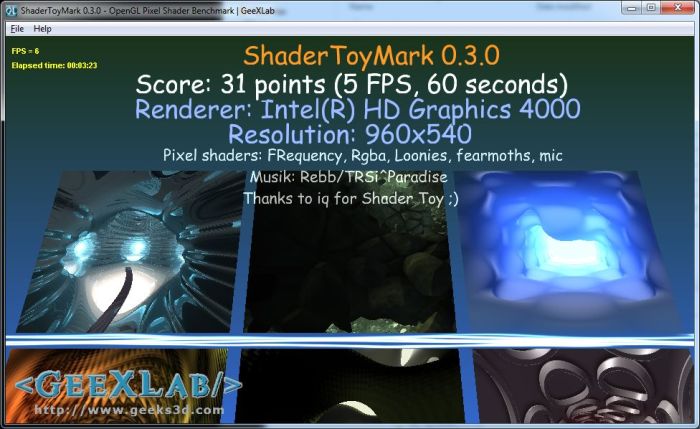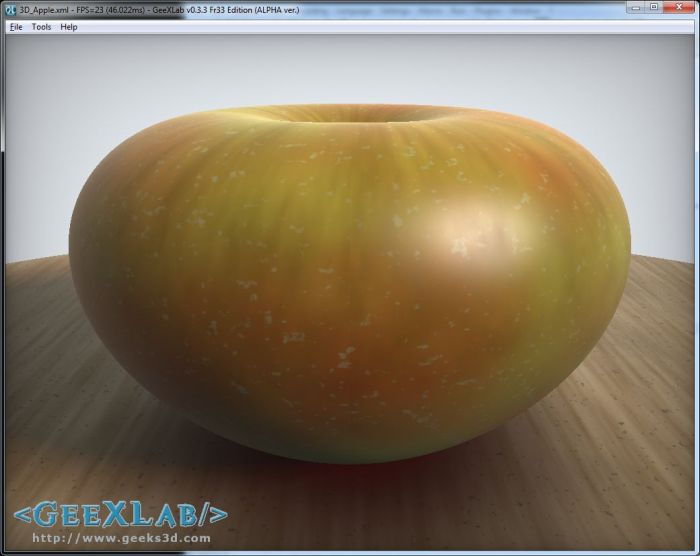Intel Ivy Bridge HD 4000 GPU test – Index
2 – Ivy Bridge – OpenGL Side

That said, let’s see first the OpenGL side of the HD 4000. The latest Intel graphics drivers (v2696, I can’t remember where I downloaded it, I will re-test the HD 4000 when v2712 or newer will be publicly available) expose OpenGL 3.3 API (Build 8.15.10.2696) with 132 OpenGL extensions (GL=118 and WGL=14). Compared to the Sandy Bridge HD 2000 with driver v2656, 3 new OpenGL extensions have been added:
- GL_ARB_blend_func_extended
- GL_ARB_geometry_shader4
- GL_ARB_texture_multisample
Here is the complete list of all 132 extensions revealed by GPU Caps Viewer 1.16.0:
- GL_EXT_blend_minmax
- GL_EXT_blend_subtract
- GL_EXT_blend_color
- GL_EXT_abgr
- GL_EXT_texture3D
- GL_EXT_clip_volume_hint
- GL_EXT_compiled_vertex_array
- GL_SGIS_texture_edge_clamp
- GL_SGIS_generate_mipmap
- GL_EXT_draw_range_elements
- GL_SGIS_texture_lod
- GL_EXT_rescale_normal
- GL_EXT_packed_pixels
- GL_EXT_texture_edge_clamp
- GL_EXT_separate_specular_color
- GL_ARB_multitexture
- GL_EXT_texture_env_combine
- GL_EXT_bgra
- GL_EXT_blend_func_separate
- GL_EXT_secondary_color
- GL_EXT_fog_coord
- GL_EXT_texture_env_add
- GL_ARB_texture_cube_map
- GL_ARB_transpose_matrix
- GL_ARB_texture_env_add
- GL_IBM_texture_mirrored_repeat
- GL_EXT_multi_draw_arrays
- GL_NV_blend_square
- GL_ARB_texture_compression
- GL_3DFX_texture_compression_FXT1
- GL_EXT_texture_filter_anisotropic
- GL_ARB_texture_border_clamp
- GL_ARB_point_parameters
- GL_ARB_texture_env_combine
- GL_ARB_texture_env_dot3
- GL_ARB_texture_env_crossbar
- GL_EXT_texture_compression_s3tc
- GL_ARB_shadow
- GL_ARB_window_pos
- GL_EXT_shadow_funcs
- GL_EXT_stencil_wrap
- GL_ARB_vertex_program
- GL_EXT_texture_rectangle
- GL_ARB_fragment_program
- GL_EXT_stencil_two_side
- GL_ATI_separate_stencil
- GL_ARB_vertex_buffer_object
- GL_EXT_texture_lod_bias
- GL_ARB_occlusion_query
- GL_ARB_fragment_shader
- GL_ARB_shader_objects
- GL_ARB_shading_language_100
- GL_ARB_texture_non_power_of_two
- GL_ARB_vertex_shader
- GL_NV_texgen_reflection
- GL_ARB_point_sprite
- GL_ARB_fragment_program_shadow
- GL_EXT_blend_equation_separate
- GL_ARB_depth_texture
- GL_ARB_texture_rectangle
- GL_ARB_draw_buffers
- GL_ARB_color_buffer_float
- GL_ARB_half_float_pixel
- GL_ARB_texture_float
- GL_ARB_pixel_buffer_object
- GL_EXT_framebuffer_object
- GL_ARB_draw_instanced
- GL_ARB_half_float_vertex
- GL_ARB_occlusion_query2
- GL_EXT_draw_buffers2
- GL_WIN_swap_hint
- GL_EXT_texture_sRGB
- GL_ARB_multisample
- GL_EXT_packed_float
- GL_EXT_texture_shared_exponent
- GL_ARB_texture_rg
- GL_ARB_texture_compression_rgtc
- GL_NV_conditional_render
- GL_EXT_texture_swizzle
- GL_ARB_sync
- GL_ARB_framebuffer_sRGB
- GL_EXT_packed_depth_stencil
- GL_ARB_depth_buffer_float
- GL_EXT_transform_feedback
- GL_EXT_framebuffer_blit
- GL_EXT_framebuffer_multisample
- GL_ARB_framebuffer_object
- GL_EXT_texture_array
- GL_EXT_texture_integer
- GL_ARB_map_buffer_range
- GL_EXT_texture_snorm
- GL_ARB_blend_func_extended
- GL_INTEL_performance_queries
- GL_ARB_copy_buffer
- GL_ARB_sampler_objects
- GL_NV_primitive_restart
- GL_ARB_seamless_cube_map
- GL_ARB_uniform_buffer_object
- GL_ARB_depth_clamp
- GL_ARB_vertex_array_bgra
- GL_ARB_shader_bit_encoding
- GL_ARB_draw_buffers_blend
- GL_ARB_geometry_shader4
- GL_ARB_texture_query_lod
- GL_ARB_explicit_attrib_location
- GL_ARB_draw_elements_base_vertex
- GL_ARB_instanced_arrays
- GL_ARB_fragment_coord_conventions
- GL_EXT_gpu_program_parameters
- GL_ARB_texture_buffer_object_rgb32
- GL_ARB_compatibility
- GL_ARB_texture_rgb10_a2ui
- GL_ARB_texture_multisample
- GL_ARB_vertex_type_2_10_10_10_rev
- GL_ARB_timer_query
- GL_ARB_vertex_array_object
- GL_ARB_provoking_vertex
- GL_EXT_gpu_shader4
- WGL_EXT_depth_float
- WGL_ARB_buffer_region
- WGL_ARB_extensions_string
- WGL_ARB_make_current_read
- WGL_ARB_pixel_format
- WGL_ARB_pbuffer
- WGL_EXT_extensions_string
- WGL_EXT_swap_control
- WGL_ARB_multisample
- WGL_ARB_pixel_format_float
- WGL_ARB_framebuffer_sRGB
- WGL_ARB_create_context
- WGL_EXT_pixel_format_packed_float
- WGL_EXT_swap_control_tear
Now some OpenGL tests.
FurMark 1.10.0
I used FurMark 1.10.0 and ran the Preset:720 (1280×720 fullscreen). More scores can be found HERE.
| – MSI Radeon HD 7970 (GPU@925MHz, mem@1375MHz), Catalyst 12.3 whql (Win 7 64-bit) – 5055 points (84 FPS) |
| – MSI GeForce 9600 GT Diamond (GPU@650MHz, mem@850MHz), R301.24 beta (branch r301_07-12, Win 7 64-bit) – 586 points (9 FPS) |
| – Intel Ivy Bridge Core i7 (2.2GHz), HD 4000, driver v8.15.10.2669 (Win 7 64-bit) – 275 points (4 FPS), |
| – ASUS Radeon HD 2400 (GPU@525MHz, mem@400MHz), Catalyst 12.3 whql (Win 7 64-bit) – 64 points (1 FPS) |
ShaderToyMark 0.3.0
ShaderToyMark 0.3.0 is a 100% GLSL pixel shader benchmark. More information is available HERE.

Settings: 960×540 windowed.
| – ASUS Radeon HD 7770 DC TOP, Catalyst 12.3 whql (Win 7 64-bit) – 215 points (35 FPS) |
| – MSI GeForce GTX 260, R296.10 (Win 7 64-bit) – 33 points (5 FPS) |
| – Intel Ivy Bridge Core i7 (2.2GHz), HD 4000, driver v8.15.10.2669 (Win 7 64-bit) – 31 points (5 FPS), |
Procedural Apple
The procedural apple is a pixel shader test made with GeeXLab (OpenGL 2 / GLSL). More information about this test can be found HERE.

Settings: 1024×768 windowed.
| – EVGA GeForce GTX 680, R301.24 (Win 7 64-bit) – 346 FPS |
| – Intel Ivy Bridge Core i7 (2.2GHz), HD 4000, driver v8.15.10.2669 (Win 7 64-bit) – 24 FPS, |
Yes I know the comparison between the HD 4000 and the GTX 680 is not really fair. It’s just for fixing some numbers.
Intel Ivy Bridge HD 4000 GPU test – Index
I wonder how well Rage runs on this.
My AMD APU can get 40-50 FPS in Rage.
Intel said, the are still to deliver a properly optimized driver for IVB’s graphics unit, probably later this year.
In addition to Rage I wonder if you can test with these OpenCL tests:
*GPCBenchmark 1.1 (hard to find it’s on
http://forum.beyond3d.com/showpost.php?p=1466478&postcount=91)
*Bullet OpenCL rigid body pipeline (https://github.com/downloads/erwincoumans/experiments/gpu_rigidbody_2012_feb11.zip)
possibly lower the number of bodies..
Can you try to run some of this apps on Intel HD 4000
1) http://scalibq.wordpress.com/2010/11/25/running-nvidias-endless-city-tessellation-demo-on-radeons/
2)
http://developer.amd.com/samples/demos/pages/RadeonHD6900SeriesRealTimeDemos.aspx
3)Ladybug Demo http://developer.amd.com/samples/demos/pages/ATIRadeonHD5800SeriesRealTimeDemos.aspx
Result can be very interesting so I will be glad if you try do that
Please give millisecond results rather than FPS – FPS is non-linear, skewing the results, and I’m not smart enough to convert in my head 🙂
@oscarbg the Bullet OpenCL gpu rigid body pipeline doesn’t work on Ivy Bridge yet, it only runs fine on latest Radeon and Fermi, Kepler gpus. I try to make it compatible, I just got the Ivy Bridge myself.
@erwincoumans good to know you have IVB now and fixing it to work..
I am wondering how would one detect something bad happens with opencl. One of the tests above showed incorrect result without an error message. How would oen know running a computational task that it run fine?
Any idea what motherboard was used in these tests?